Related Research Articles

Mammoth Cave National Park is a national park in south-central Kentucky, encompassing portions of Mammoth Cave, the longest cave system known in the world. The park's 52,830 acres (21,380 ha) are located primarily in Edmonson County, with small areas extending eastward into Hart and Barren counties. The Green River runs through the park, with a tributary called the Nolin River feeding into the Green just inside the park.

The Natural Bridge Caverns are the largest commercial caverns in the US state of Texas. The name is derived from the 60-foot (18 m) natural limestone slab bridge that spans the amphitheater setting of the cavern's entrance. The span was left suspended when a sinkhole collapsed below it.

Blanchard Springs Caverns is a cave system located in the Ozark–St. Francis National Forest in Stone County in northern Arkansas, USA, 2 miles (3.2 km) off Highway 14 a short distance north of Mountain View. It is the only tourist cave owned by the United States Forest Service and the only one owned by the federal government outside the National Park System. Blanchard Springs Caverns is a three-level cave system, all of which can be viewed on guided tours.

Kartchner Caverns State Park is a state park of Arizona, United States, featuring a show cave with 2.4 miles (3.9 km) of passages. The park is located 9 miles (14 km) south of the town of Benson and west of the north-flowing San Pedro River. Long hidden from view, the caverns were discovered in 1974 by local cavers, assisted by state biologist Erick Campbell who helped in its preservation.

Bluespring Caverns is a cave system located in Lawrence County, Indiana, approximately 80 miles (128 km) south of Indianapolis. The cave system is a karst and river type cave formation and drains a 15 miles² (38.8 km²) sinkhole plain. The cave contains 21 miles (34 km) of surveyed passages and is most notable for having the longest known subterranean river in the United States with approximately 3 miles (4.8 km) of navigable river.

Colossal Cavern is a cave in Kentucky, United States, the main entrance of which is at the foot of a steep hill beyond Eaton Valley, and 1.5 miles from Mammoth Cave.

Marengo Cave is a privately owned cave located in Marengo, Indiana. One of only four show caves in Indiana, public tours of the cave have been given since 1883. Tours commenced just days after the cave's discovery by two school children. The cave was designated as a National Natural Landmark in 1984.

The Jeita Grotto is a system of two separate, but interconnected, karstic limestone caves spanning an overall length of nearly 9 kilometres (5.6 mi). The caves are situated in the Nahr al-Kalb valley within the locality of Jeita, 18 kilometres (11 mi) north of the Lebanese capital Beirut. Though inhabited in prehistoric times, the lower cave was not rediscovered until 1836 by Reverend William Thomson; it can only be visited by boat since it channels an underground river that provides fresh drinking water to more than a million Lebanese.
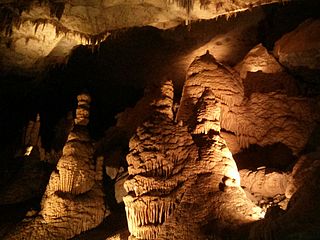
Cumberland Caverns is a national natural landmark and show cave located in McMinnville, Tennessee. It is the second longest cave in Tennessee and makes the list of longest caves in the United States and in the world.
Cold Water Spring State Preserve is a 60-acre (240,000 m2) parcel state preserve protecting a spring that issues from Cold Water Cave, an extensive cave system in Winneshiek County, Iowa and Fillmore County, Minnesota. The spring is a tributary of the Upper Iowa River.

Dos Ojos is part of a flooded cave system located north of Tulum, on the Caribbean coast of the Yucatán Peninsula, in the state of Quintana Roo, Mexico. The exploration of Dos Ojos began in 1987 and still continues. The surveyed extent of the cave system is 82 kilometers (51 mi) and there are 28 known sinkhole entrances, which are locally called cenotes. In January 2018, a connection was found between Sistema Dos Ojos and Sistema Sac Actun. The smaller Dos Ojos became a part of Sac Actun, making the Sistema Sac Actun the longest known underwater cave system in the world.
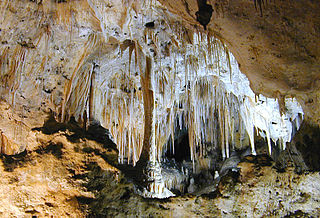
Carlsbad Caverns National Park is an American national park in the Guadalupe Mountains of southeastern New Mexico. The primary attraction of the park is the show cave Carlsbad Cavern. Visitors to the cave can hike in on their own via the natural entrance or take an elevator from the visitor center.

Onondaga Cave State Park is a Missouri state park located on the Meramec River approximately 5 miles (8.0 km) southeast of the village of Leasburg. The park was established in 1982. Park activities include cave tours, camping, fishing, hiking, picnicking, and swimming.
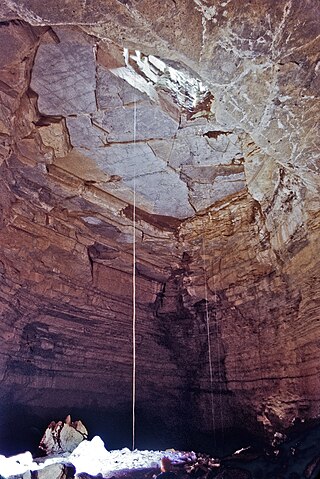
Hellhole is a large and deep pit cave in Germany Valley of eastern West Virginia. It is the seventh longest cave in the United States and is home to almost half of the world's population of Virginia big-eared bats. At 737 feet (225 m), Hellhole is the deepest of several caves in the Valley.
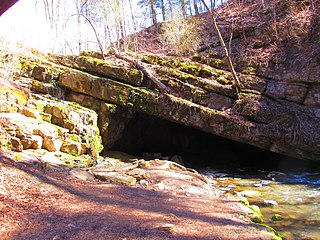
Tytoona Cave is located approximately 1-mile (1.6 km) from Arch Springs, Pennsylvania in Sinking Valley, near Tyrone and Altoona, in the United States.

Grand Caverns, formerly known as Weyer's Cave, is located in the central Shenandoah Valley in the town of Grottoes, Virginia, United States. A limestone cavern, it claims the distinction of being America's oldest show cave, in operation since 1806.

Stump Cross Caverns is a limestone cave system between Wharfedale and Nidderdale in North Yorkshire, England.

The Parque Nacional de las Cavernas del Río Camuy is a cave system in Puerto Rico. It is located between the municipalities of Camuy, Hatillo, and Lares in northwestern Puerto Rico, but the main entrance to the park is located in Quebrada, Camuy. The caverns are part of a large network of natural limestone caves and underground waterways carved out by the third-largest underground river in the world, the Río Camuy. The cave system was "discovered" in 1958 and was first documented in the 1973 book Discovery at the Río Camuy (ISBN 0-517-50594-0) by Russell and Jeanne Gurnee, but there is archaeological evidence that these caves were explored hundreds of years ago by the Taíno Indians, Puerto Rico's first inhabitants. Over 10 miles of caverns, 220 caves and 17 entrances to the Camuy cave system have been mapped so far. This, however, is only a fraction of the entire system which many experts believe still holds another 800 caves. Only a small part of the complex is open to the public. The 268-acre park built around the cave system features tours of some of the caves and sinkholes, and is one of the most popular natural attractions in Puerto Rico. After restorations necessitated by Hurricane Maria, a destructive storm that struck Puerto Rico in 2017, the park re-opened on March 24, 2021. It then closed again from September, 2022 until February, 2023 due to Hurricane Fiona.
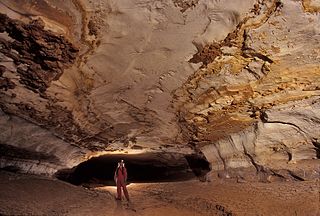
Blue Spring Cave is a cave located in White County, Tennessee, on the north side of Blue Spring Cove. Blue Spring Cave is Tennessee's longest cave and the 9th longest cave in the United States.
Tyson Spring Cave is a cave located in southeastern Minnesota's Fillmore County. The region is within the Driftless Area, a region noted for its karst topography, which includes caves and sinkholes. Tyson's cave is a solutional cave privately owned by the Minnesota Cave Preserve. It is known for the extinct ice-age bones found scattered throughout the cave rooms. The majority of this extensive cave is approximately 120 feet below the surface and is estimated to be 3.5–5 miles in length, making it the 258th longest cave in the United States.
References
- ↑ Caverbob.com, Retrieved October 21, 2012
- ↑ "Spring Valley Caverns". Minnesota Cave Preserve. Retrieved 12 March 2014.
Located on the privately owned Cave Preserve, the system measures about 5½ miles in length, making it the largest privately owned system in Minnesota. [1] It is listed as the 138th longest in the United States